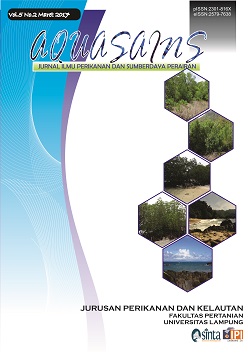ANALYSIS OF DIFFERENT NATURAL FEED CONSUPMTION ON GROWTH AND SURVIVAL RATE OF EEL (Monoptherus albus) IN CLEAR WATER SYSTEM
Abstract
This study used an experimental method with Completely Randomized Design
4 treatment 3 replication The results showed that the giving of various types of feed gave significant effect (P <0,05) to EPP and RGR but not significant (P> 0,05) to PER and survival rate. The feed that can increase EPP and RGR is the silk worm and snail. The feed of silk worm and snail can produce EPP of 7.33% and 5.75% while RGR value is 2.24% / day and 1.73% / day. The feed that can increase PER is a silk worm capable of generating PER of 0.23%. Water quality in maintenance media is in the appropriate range for the growth of rice eel (M. albus). Based on the results of research can be concluded that the feed that can increase eel growth is by giving the silk worm.

.png)










